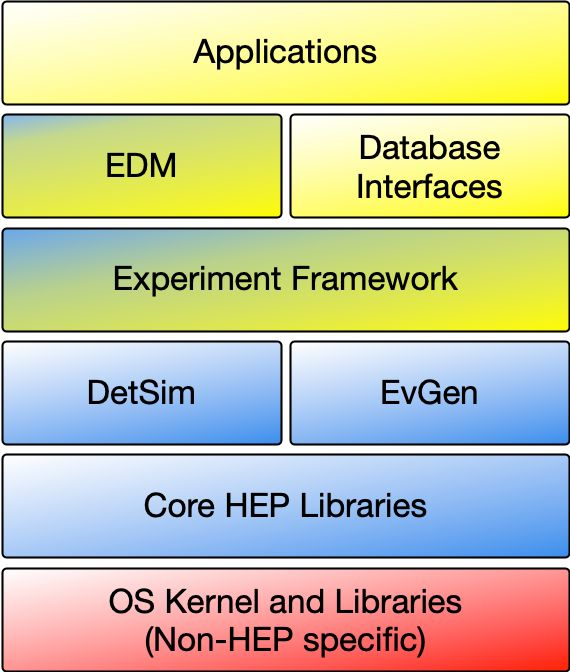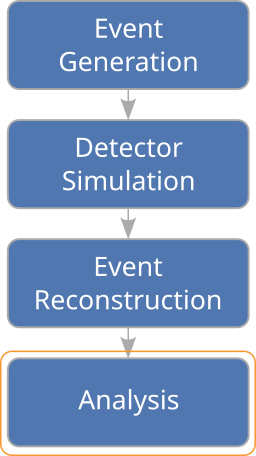Analysis and visualization
Juraj Smieško
6th FCC Physics Workshop in Kraków
24 January 2023
Key4hep
- Set of common software packages, tools, and standards for different Detector concepts
- Common for FCC, CLIC/ILC, CEPC, EIC, …
- Individual participants can mix and match their stack
-
Main ingredients:


Analysis
Analysis scope
- Takes reconstructed objects and produces physics results
- The objects are described in EDM4hep format
- Input datasets are usually centrally produced
- Access to the detector description
- Needs to accommodate different analysis strategies
- Runs locally and on Batch/Grid

Ecosystem I.
The physics analyses at FCC are spread through two repositories and a storage space:
-
FCCAnalyses
- Repository of common tools and algorithms
- General analysis code in analyzers
- Steering of the analysis (RDataFrame)
- Access to the (meta)data
- Running over large datasets / on batch
- (Proto)package machinery for case studies
-
FCCeePhysicsPerformance
- Main place for the abstracts
- Contains very specific analysis code
- Or prototypes of tools of common interest to be eventually moved to FCCAnalysis
- (Proto)package repository
- Storage space on EOS /eos/experiment/fcc


Ecosystem II.
Supporting repositories:
- WebTools
- Code for the website hosting dataset info
- FCC-config
- Stores configurations for the datasets
- EventProducer
- Responsible for production of input datasets
- fcc-tutorials


RDataFrame

- Describes processing of data as actions on table columns
- The actions are instantly or lazily evaluated
- Multi threading is available out of the box
- Optimized for bulk processing
Architecture
- The analysis is build around ROOT RDataFrame with rich "standard library"
- Over the years this library (analyzers) have been written
- Analyzers are usually structs which operate on EDM4hep objects
- Optional dependencies for analyzers can be FastJet, DD4hep, ACTS and ONNX
-
Dataset metadata are loaded from remote location --- AFS/HTTP server
-
Number of events generated, cross-section, ...
-
Python used for steering, but not necessary
- One can write analysis in pure C++

FCCAnalyses library
- Vertexing
- ACTS vertex finder
- Event variables
- Calorimeter hit/cluster variables
- Reconstructed/MC particle operations
- Flavour tagging
- Jet clustering/constituents

Workflow
-
The analysis is divided into three stages:
- analysis_stage1.py, ... — pre-selection stages, analysis dependent, usually runs on batch
- analysis_final.py — final selection, produces final variables
- analysis_plots.py — produces plots from histograms/TTrees
- The stages files contain objects which are loaded into "main" function with the help of getattr()
- The first stage reads the data in EDM4hep format
- Running on batch is done by running on-the-fly generated shell script in subprocess
Proto packages
case-studies machinery allows to create (semi)independent analysis
Example analysis is split into several locations:
- Analysis stages are in examples in FCCAnalyses
- Abstract and Results in case-studies in FCCeePhysicsPerformance
- Benchmarks are in tests in FCCAnalyses
- Analysis specific code in case-studies in FCCeePhysicsPerformance
Areas to improve I.
- Debugging tools
- Individual event investigation + visualization
- Integration with the production system
-
- Migration to Dirac
- Automatic deployment of new samples
- Rigidity of the FCCAnalysis framework
- Restrictive predefined stages
- Weaver analysis example:
- Analysis "properly" implements only first stage
- Requires custom stage for training/testing
- Place to store common objects/variables between stages
- All python machinery crammed into one module
Needs to be addressed for the FSR:


Areas to improve II.
Nice to have:
- Error signaling
- Testing and reorganization of the analyzers
- Long term reproducibility
- Benchmarking covering all analyzers and analyses

Visualization
Main use cases
Detector
- Detector description in DD4hep format
- Combination of C++ and XML
- Conversion available to:
- ROOT, GDML, glTF
- Can be viewed in:
- geoDisplay, Geant4, JSROOT, Phoenix
Events
- Events could come from different sources in EDM4hep format
- Full simulation: Pythia
- Fast simulation: Delphes
- Simple particle gun
- Storage formats:
- ROOT, JSON
- Viewers:
- Phoenix, CED
Web based visualization
Phoenix workflow
Conclusions & Outlook
- Choice of ROOT RDataFrame in combination with reading EDM4hep format suits most of the analyses
- Continually growing list of analyses
- Large "standard library" is being build up
- Rigidity of the framework starts to limit more complex analyses
- Several ways of visualizing event data and detector geometry readily available
- Necessity of bridging the gap between the FCC stack and the graphic subsystem of the OS
More heads
are welcome!
are welcome!





